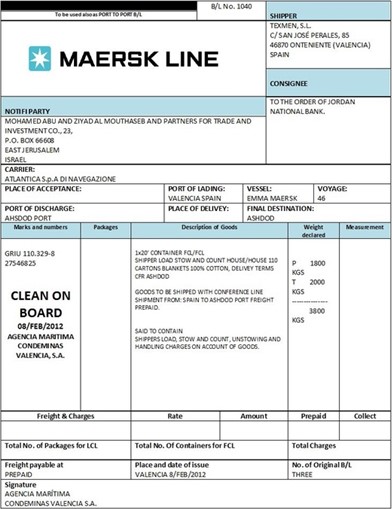The Bill of Lading
Maritime operations are renown for their complexity and international nature, as a single transaction might involve several different means of transport, parties and, most importantly, documentation, which is often issued in different countries and stages of the supply chain. Undoubtedly, one of the key documents concerning international seaborne trade is the Bill of Lading, normally abbreviated – and hereinafter referred to – as B/L.
The B/L is a legal instrument stipulating the goods being shipped, issued to the shipper by the carrier, the master of the ship the merchandise has been loaded onto or even by some freight forwarders (NVOCC). Essentially, it provides all parties with crucial information regarding a specific consignment, such as the description, freight, quantity, identification marks, gross weight, hazardous nature, ports of origin and destination or even the content, when it comes to closed container shipments. In these cases, the B/L will also mention the STC Clause (“Said to Contain”), as cargo cannot be physically verified and it depends on the declaration of the shipper.
Furthermore, a B/L may also be issued either on paper, the most common scenario, or in a digital, blockchain-based format, also known as the electronic or paperless Bill of Lading (e-B/L).
However, the B/L is not only used to convey the details of a shipment, but it is also an essential document that may even be required to obtain a letter of credit, insurance or to assign liability in case of mishap (e.g. loss of containers overboard). In fact, this document, however complex it may be, serves three main functions, namely:
• It is evidence of the contract of carriage between carrier and shipper, also reflecting on the reverse side the line’s terms and conditions under which transport ought to be carried out. Nevertheless, it must be noted that the B/L is not the contract of carriage itself, but a document that is an intrinsic part of how the shipping should be undertaken, albeit a rather controversial issue, giving rise to different interpretations;
• Once it has been issued it serves as a shipment receipt which, according to the Hague-Visby Rules, means that it is prima facie evidence that the carrier has received the goods on board in sound condition and as agreed. In case of discrepancies regarding the description of the goods, however, these will be noted on the B/L, indicating the actual condition of the consignment at the time of loading;
• The B/L also acts as a document of title, conferring its legitimate holder or named receiver (i.e. the consignee, a bank or a third party through endorsement) numerous rights, such as the seller’s right to retain the bill until payment is fulfilled, the right of disposal of the goods or, most importantly, the right to receive the shipment and claim its possession, enabling the cargo to be released upon presentation of an original B/L by the holder to the master or carrier at destination. The B/L, therefore, does not transfer ownership but possession of the merchandise, as the former normally depends on the subjacent sales contract, although this is also a controversial topic for many shipping professionals. Normally three original bills are released, one for each party (carrier, shipper, banks/brokers/underwriters), notwithstanding as it authorizes the bearer to legally claim the goods, the number of bills issued should be kept to a bare minimum to avoid issues such as theft or fraud.
Although this document is crucial for international maritime transactions, it contains certain drawbacks. For instance, each original of the B/L has to be physically sent (i.e. through courier services) to every party involved , which may result in the vessel – and, therefore, the cargo – arriving before the bill, possibly hindering the release of the goods, or even loss of the documentation during transport. Moreover, the traditional paper format is expensive, environmentally unfriendly and forgeable. Hence, as crucial as the content of the document may be, it is equally as important to understand its purpose and to use it with the utmost good faith and due diligence, thereby minimizing possible damage or loss to third parties and costly proceedings.

Credit: Ingeniero Marino. https://ingenieromarino.com/el-trabajo-de-la-marina-mercante/
- West P&I Claims Guides: Bill of Lading 1 and 5. On https://www.westpandi.com/getattachment/907f94bf-b7dd-469e-913f-4baae23fca1d/p-i_guide_bills_of_lading_1_2pp_v2_lr.pdf and https://www.westpandi.com/getattachment/fa2a3cc4-500f-4a8a-aff3-6d040ef57d60/p-i_guide_bills_of_lading_5_4pp_v2_lr-1-.pdf
- The Hague-Visby Rules (Hague Rules as Amended by the 1968 Brussels Protocol)
- Plomaritou, Evi & Voudouris, Ioannis. (2019). The Relationships of Bill of Lading, Charterparty and Other Transport Documents. Journal of Economics, Management and Trade. 1-8. 10.9734/jemt/2019/v24i630182
- Biswas, Liton. (2011). A Discussion and Analysis of the Bill of Lading as a Document of Title. SSRN Electronic Journal. 10.2139/ssrn.2089523.
- Marine Insight, “Bill of Lading in Shipping: Importance, Purpose and Types”. On https://www.marineinsight.com/maritime-law/what-is-bill-of-lading-in-shipping/#:~:text=As%20the%20bill%20of%20lading,of%20the%20bill%20of%20lading.
- GARD P&I, “Functions of the bill of lading and waybill: Document of title”. On http://www.gard.no/web/publications/document/chapter?p_subdoc_id=6144&p_document_id=6143#:~:text=1%20Document%20of%20title,-1.2.1.1%20Meaning&text=Title%20in%20the%20context%20of,sales%20contract%20usually%20determines%20this.
Related links
Main menu






